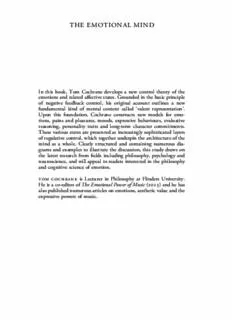
The emotional mind : a control theory of affective states PDF
Preview The emotional mind : a control theory of affective states
THE EMOTIONAL MIND In this book, Tom Cochrane develops a new control theory of the emotionsandrelatedaffectivestates.Groundedinthebasicprinciple of negative feedback control, his original account outlines a new fundamental kind of mental content called ‘valent representation’. Upon this foundation, Cochrane constructs new models for emo- tions, pains and pleasures, moods, expressive behaviours, evaluative reasoning, personality traits and long-term character commitments. Thesevariousstatesarepresentedasincreasinglysophisticatedlayers ofregulativecontrol,whichtogetherunderpinthearchitectureofthe mind as a whole. Clearly structured and containing numerous dia- grams and examples to illustrate the discussion, this study draws on the latest research from fields including philosophy, psychology and neuroscience,andwillappealtoreaders interestedinthephilosophy and cognitive science ofemotion. is Lecturer in Philosophy at Flinders University. Heisaco-editorofTheEmotionalPowerofMusic()andhehas alsopublishednumerousarticlesonemotions,aestheticvalueandthe expressive powers ofmusic. Downloaded from https://www.cambridge.org/core. University of Sussex Library, on 05 Jan 2019 at 21:57:31, subject to the Cambridge Core terms of use, available at https://www.cambridge.org/core/terms. https://doi.org/10.1017/9781108579056 Downloaded from https://www.cambridge.org/core. University of Sussex Library, on 05 Jan 2019 at 21:57:31, subject to the Cambridge Core terms of use, available at https://www.cambridge.org/core/terms. https://doi.org/10.1017/9781108579056 THE EMOTIONAL MIND ff A Control Theory of A ective States TOM COCHRANE FlindersUniversity Downloaded from https://www.cambridge.org/core. University of Sussex Library, on 05 Jan 2019 at 21:57:31, subject to the Cambridge Core terms of use, available at https://www.cambridge.org/core/terms. https://doi.org/10.1017/9781108579056 UniversityPrintingHouse,Cambridge,UnitedKingdom OneLibertyPlaza,thFloor,NewYork,,USA WilliamstownRoad,PortMelbourne,,Australia –,rdFloor,Plot,SplendorForum,JasolaDistrictCentre,NewDelhi–,India AnsonRoad,#–/,Singapore CambridgeUniversityPressispartoftheUniversityofCambridge. ItfurtherstheUniversity’smissionbydisseminatingknowledgeinthepursuitof education,learning,andresearchatthehighestinternationallevelsofexcellence. www.cambridge.org Informationonthistitle:www.cambridge.org/ :./ ©TomCochrane Thispublicationisincopyright.Subjecttostatutoryexception andtotheprovisionsofrelevantcollectivelicensingagreements, noreproductionofanypartmaytakeplacewithoutthewritten permissionofCambridgeUniversityPress. Firstpublished PrintedandboundinGreatBritainbyClaysLtd,ElcografS.p.A. AcataloguerecordforthispublicationisavailablefromtheBritishLibrary. ----Hardback CambridgeUniversityPresshasnoresponsibilityforthepersistenceoraccuracy ofURLsforexternalorthird-partyinternetwebsitesreferredtointhispublication anddoesnotguaranteethatanycontentonsuchwebsitesis,orwillremain, accurateorappropriate. Downloaded from https://www.cambridge.org/core. University of Sussex Library, on 05 Jan 2019 at 21:57:31, subject to the Cambridge Core terms of use, available at https://www.cambridge.org/core/terms. https://doi.org/10.1017/9781108579056 Contents List of Figures page x List of Tables xi Acknowledgements xii Introduction . TheBigPicture . InSearchofSynthesis . ThePerceptualTheory . TheStrategyofThisBook Valent Representation . Foundations . TheProblemofMentalContent . NegativeFeedbackLoops . Life . EnactivismversusRepresentationalism . SomeFeaturesofValentRepresentation . FourElaborations . Conclusion Affect . AffectiveStates . AnInitialDistinction . ValentTreatment . Imperativism . Prioritisation . PleasureasSuccess . ThePainfulTruth . Conclusion Emotions . ANaturalKind . EmotionasValentRepresentation . FormalObjects vii Downloaded from https://www.cambridge.org/core. University of Sussex Library, on 05 Jan 2019 at 21:58:55, subject to the Cambridge Core terms of use, available at https://www.cambridge.org/core/terms. https://doi.org/10.1017/9781108579056 viii Contents . RepresentingContrasts . Surprise . NewConcerns . ResponseFlexibility . Conclusion Bodily Feelings . AdditionalContent . EmotionswithoutFeelings . Moods . AssociativeAccountsofFeeling . EmotionalSpace . EmotionalConcepts . CopingPotential . TheEmotionsDebate Expression . BodilyMusic . SignallingandShowing . SocialEmotions . AgainstIndividualism . CollectiveIntentionality . SocialNorms . CollectiveEffervescence . Conclusion Conscious Thought . ExtendingtheModel . Checking . Thought-StimulatedEmotion . Planning . TheInternalMonologue . MotivatedThought . EmotionRegulation . Conclusion Personality and Character . AnIdeal . PersonalityTraits . TheBigFive . TheNatureofCharacter . Sentiments . Narratives . CharacterinCharge . Conclusion Downloaded from https://www.cambridge.org/core. University of Sussex Library, on 05 Jan 2019 at 21:58:55, subject to the Cambridge Core terms of use, available at https://www.cambridge.org/core/terms. https://doi.org/10.1017/9781108579056 Contents ix Control . WhereAmI? . Person-LevelAgency . DynamicSystems . TwoPrinciples . ControlArchitecture . TheBrain . ExtendedEmotion . ConclusiontoThisBook Appendix Emotion Dimensions A. Definitions A. Applications Glossary Bibliography Index Downloaded from https://www.cambridge.org/core. University of Sussex Library, on 05 Jan 2019 at 21:58:55, subject to the Cambridge Core terms of use, available at https://www.cambridge.org/core/terms. https://doi.org/10.1017/9781108579056 Figures . A negative feedback loop page . An avoidant loop . An attractant loop . A nonrepresentational negative feedback loop . Contrasting an enactivist loop (left) with a valent representation loop (right) . An example of exploratory action . Mutually inhibiting connections between distinct valent representations . The separation of detections from commands . An example of higher-order representation . A four-link avoidant negative feedback loop . The success theory of pleasure . Pleasurable affect generated by an underlying satiety loop . The contrast between pleasures and pains . A schema for fear . Bodily feelings in fear used to assess coping potential . The loops of emotion and conscious thought A. Basic emotion terms poorly differentiated using the two-dimensional valence-arousal model A. Basic emotion terms better differentiated by the dimensions of power and temporal orientation A. Sadness-family terms differentiated by dimensions of social connection and temporal duration A. Nervousness sub-class terms differentiated by dimensions of focus and certainty x Downloaded from https://www.cambridge.org/core. University of Sussex Library, on 05 Jan 2019 at 21:59:14, subject to the Cambridge Core terms of use, available at https://www.cambridge.org/core/terms. https://doi.org/10.1017/9781108579056 Tables . Control architecture of the mind page A. Culturally specific emotion terms A. Subtle expressive language xi Downloaded from https://www.cambridge.org/core. University of Sussex Library, on 05 Jan 2019 at 21:59:44, subject to the Cambridge Core terms of use, available at https://www.cambridge.org/core/terms. https://doi.org/10.1017/9781108579056 Acknowledgements The development of this book has benefitted from the insights and support of a number of people over the years. The key ideas were developed during the three years I spent between and as a postdoctoral researcher at the Swiss Center for Affective Sciences led by Klaus Scherer. There, I learned a great deal from discussions with Kevin Mulligan, Fabrice Teroni, Julien Deonna, Olivier Massin, Otto Bruun, Federico Lauria, Anna Ogarkova, Cain Todd and Íngrid Vendrell Ferran. In the years following, at Queen’s University Belfast, Ben Jarvis always gave me something new to think about. During my time at Sheffield University, Chris Bennett and Luca Barlassina were extremely supportive (Luca in particular turned me on to pain). Both read a draft of the entire manuscript and helped me beat this book into shape. In addition, I have benefitted from various interactions with Jenefer Robinson, Jesse Prinz, Peter Goldie, Michael Brady, Stefan Koelsch, Sylvia Kreibig, Wiebke Trost, Giovanna Colombetti, Tom Roberts and Joel Krueger. ThankstoHilaryGaskin,SophieTaylor,LorenzaToffolon,Divyabhar- athi Elavazhagan and Susan Beckett at Cambridge for seeing this book throughthepublicationprocess,andthanksespeciallytothereferees–Joel Smith and Matthew Fulkerson – who provided both detailed comments and much needed encouragement during the latter stages of this project. Finally, thanks to my wife, Ju, and children, Zephram and Karuna, for followingmearoundtheworldduringmyitinerantyearsasaphilosopher. xii Downloaded from https://www.cambridge.org/core. University of Sussex Library, on 05 Jan 2019 at 22:00:26, subject to the Cambridge Core terms of use, available at https://www.cambridge.org/core/terms. https://doi.org/10.1017/9781108579056
Description: